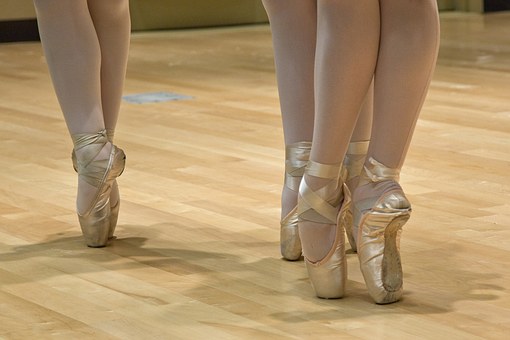In this article let’s look at how to improve ballet turnout safely, and why turnout is so important for dancers all over the world.
This article may contain affiliate links.
Why Do Dancers Need Turnout?
Why is turnout so important for dancers, especially if you do ballet or contemporary? In fact, the word ‘turnout’ may be the most commonly heard phrase used in dance classes around the world.
Dancers have been working on their 180-degree ballet turnout since the inception of ballet, and this seems to be the most desired leg position to have, regardless of whether or not dancers are pushing their bodies beyond their natural limits.
The reason dancers need to have ballet turnout is that it improves the look of ballet, makes the lines prettier, softer, and more beautiful. Turnout also enables the dancer to lift her legs higher and thus achieve higher extensions.
A turned out leg looks far prettier than a turned in one and it looks longer too.
Where Does Turnout Come From?
Unfortunately, not many people are born with natural turnout in the hip joints, which is why it has to be properly trained from a young age for years.
Beginners tend to want to emulate the “perfect turnout” by forcing their knees outward.
Of course, this method is extremely difficult to maintain while dancing, and not only that but this method will cause knee injuries over time.
Some dancers think that a consistent routine of stretching exercises will open up the hip joint’s range of motion, but it is more than simply stretching.
Turnout should never ever be forced, but rather worked on by strengthening the surrounding muscles that support and hold turnout as well as training the muscle memory with a series of ballet drills so that this becomes a natural process for the dancer over time.
Turnout initiates from the hips, not the knees or feet.
In order to understand how to achieve the greatest turnout, let’s look at the anatomy as this can help dancers get a better understanding of how everything inside works.
Turnout is supported by six deep rotator muscles surrounding the hip joint namely:
- Piriformis
- Superior Gemellus
- Inferior Gemellus
- Obturator Internus
- Obturator Externus
- Quadratus Femoris.
In addition, the Gluteus Maximus, the Posterior Fibers of the Gluteus Medius, and the Long Head of the Biceps Femoris also assist in lateral rotation.
Improve Ballet Turnout Without Injury
While most young dancers tend to focus a lot on flexibility, it is important to realize that to be truly effective and avoid injury, the muscles must not only be stretched but strengthened as well.
Always remember that with stretching comes flexibility and with strength comes stability. Both have to work together to shape the true powerhouse of a dancer.
It would be useless to gain a lot of flexibility and not actually have the strength to hold the position.
Here is a great turnout and flexibility test you can try that comes from the Easy Flexibility Program.
You will need two yoga blocks for this exercise.


The yoga blocks above can be ordered online simply by clicking on the picture if you don’t have any.
Sit on the floor with the legs extended to the front with your hands on the floor behind your hips. Place one foot on each block and turn the legs out, with the goal of placing the outer edge of the foot on the block and heels slightly hanging over the inside edge.
Keeping this position, lift the hips off of the floor and hold for up to thirty seconds. For more of a challenge, move the feet further off of the blocks, bringing the heels closer together. If this position is only able to be held for a short period, there is work to do on those turnout muscles. This test is an excellent gauge to track turnout strength over time.
Other exercises for strength in turnout can be performed in your regular ballet class. Plié and fondu are both wonderful basics that strengthen the deep rotators as well as the gluteal muscles, which is why every ballet class you attend will have these exercises incorporated into your barre work.
Each time the dancer bends, there is a chance to stretch and lengthen as the hip joint opens to the side.
As the dancer stretches again, the gluteus maximus and piriformis are working hard to stabilize in the newly found space within the joint.
If you want to give these tried and tested exercises more bang for their buck and to improve ballet turnout, finish with a balance with the leg in retiré. This will work these muscles even harder by introducing an isometric hold, connecting back to the earlier block exercise.
Not all dancers are built the same, and some may have tighter muscles in the hip joint than others.
It is important to remember to work within your own range and strengthen the muscles in your own time, not try to compete with the girl standing in front of you that seems to have a 180-degree turnout.
Work hard, learn to use the right muscles, and over time your ballet turnout will improve and strengthen, without risking long term damage to your body.

